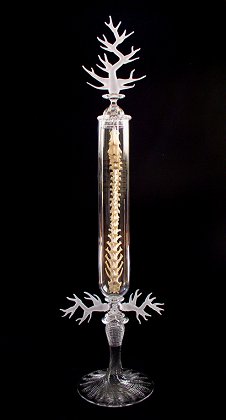GLASS QUARTERLY
Review: Andy Paiko
at Guardino Gallery (Portland, OR)
by Richard Speer
The lines between utility and aestheticism, craft and art, are perennially considered and crossed by art theorists and practitioners. Does functionality preclude artifice, and vice versa, or does one take a more Wildean approach, accepting conversation, connoisseurship, fashion, design, epicurean pursuits, and indeed life itself under the rubric of art? No less a purist for form following function than Frank Lloyd Wright turned inclusivist when his favorite extra-architectural pastimes were involved (“Dining,” he once opined, “is, and has always been, a great artistic opportunity.”). Is the division between the artisan and the artist writ large in black and white, or does it seep in imperceptible gradations from one end of the spectrum to the other? Exhausting though such meta-aesthetic hand-wringing may be, the topic is far from exhausted. In Andy Paiko’s one-person show at Guardino Gallery, the Northwest-based glass blower deals with these and related questions by re-examining and further blurring the lines between function and form.
The artist addresses the former and latter by dividing the show in two parts, both physically and thematically. In one room he displays blown-glass stemware and vessels of the sort he has created for the last ten years: delicate goblets in the Venetian tradition, tumblers, candlesticks, vases, and perfume bottles patterned with luscious swirls and judicious but vivid accents of color. These are works of considerable technical skill and visual appeal, although no one is apt to accuse them of heart-stopping originality. In the gallery’s second room are sculptural pieces drawn from Paiko’s most recent body of work, his first foray into more conceptual territory.
These cold-fused sculptures could not be further from the prosaic, if pretty, content in the other room. Paiko clouds the utility-versus-art conundrum by making his objets d’art fully functional but wholly impractical. Spinning Wheel is full-sized and fully operational in its title’s eponymous function, yet one is left to wonder why anyone would opt for a spinning wheel made out of glass. A balance scale weighs small objects and is accurate within ten ounces. Similarly, Seismograph measures tectonic vibrations along two axes. At his opening, the artist encouraged gallery-goers to jump up and down next to the instrument, so they could see it record their movements with its non-glass components, pens and spools of paper. Working hourglasses filled with sand are crowned with tiny minarets, imparting a Georgian eccentricity reminiscent of the Royal Pavilion at Brighton. More inscrutable of purpose are a series of reliquaries called Spine Jars, which contain odd and vaguely morbid curiosities: deer vertebrae, coyote skeletons, sea lion teeth, and the skulls of minks and mice. These trophy-like display cases are varied in style, some with stylized tree branches sprouting out of their sides and tops, others with twisty spires reminiscent of Bernini’s baldacchino at St. Peter’s Basilica. Some of the cases are etched with text, while others are enlivened by smatterings of citrine- and amber-colored glass. Then there is the syringe, complete with oversized plunger, which hangs from the wall, five and a half feet tall. Unless King Kong needs a flu shot any time soon, there is no conceivable purpose for such a contraption. Nor are the pieces the artist terms “pseudoelectrical devices” possessed of any discernable function. Enclosed in large bell jars and appointed with Tesla coils and a radiometer, the pieces resemble the sort of miniature Rube-Goldberg prototype one might have expected to find in Mr. Edison’s laboratory.
As a whole, Paiko’s show comes across as a vaguely musical juxtaposition of known and unknowable key signatures. The room filled with vessels plays a straightforward sonata, while the more eccentric room resounds with an etude on arcanum. Glittering under halogen light, the odd sculptures are as brilliant to look at as they are befuddling to contemplate. With their macabre bones and jutting spindles, they evoke relics of medieval saints, curio cases culled from Victoriana, or more recently, the accumulationist apothecary cabinets of Damien Hirst. Technically and visually, the works owe their effectiveness to Paiko’s favored process of working many small pieces separately, then fusing them cold, creating a collaged effect overall. Thematically, Paiko succeeds in leading the viewer to question the tenuous distinctions between practicality, decoration, and high art. The works go one step further, however, managing to emanate both menace and wit, particularly in the Spine Jars. At once crystal clear and darkly enigmatic, they beseech us to question dichotomies we might otherwise take as truisms.
—A contributing critic for ARTnews and contributing editor at Art, Ltd., Richard Speer is the author of Matt Lamb: The Art of Success (John Wiley & Sons) and is visual arts critic at Willamette Week, the Pulitzer Prize-winning alternative weekly in Portland, Oregon. He has written about cultural matters for Newsweek, Salon, The Los Angeles Times, and Opera News.
